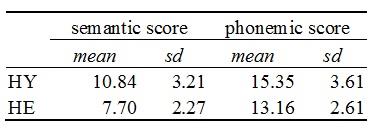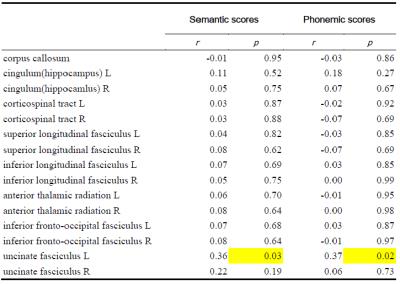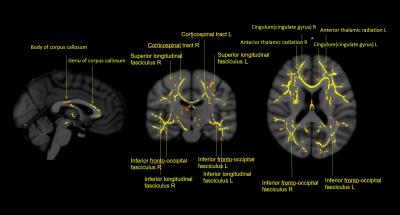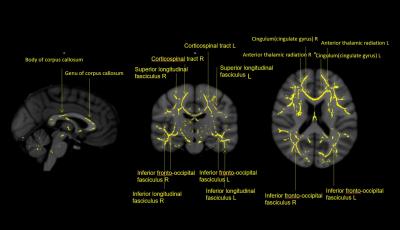1792
Age-related effect on white matter changes and lexical retrieval1Center for Cognition and Mind Sciences, National Tsing Hua University, Hsinchu, Taiwan, 2Department of Biomedical Engineering, Mingchuan University, Taiwan, 3Department of Gerontechnology, National Center for Geriatrics and Gerontology, Obu, Japan, 4Swartz Center for Computational Neuroscience, University of California San Diego, San Diego, United States
Synopsis
Identifying age-related white matter change is vital to understanding neurodegeneration. With studies focusing mainly on memory, little is known of age-related change in language function. This current study bridges the gap by investigating the relationship between changes of WM integrity and task-based language performance. The behavioural evidence revealed significant different between young and healthy elderly people in phonemic as well as semantic retrieval. Also, TBSS analysis suggest significant difference in white matter volume between the two groups. However, correlation between white matter indices, FA and MD, was not found, indicating that degeneration of language function cannot be account for solely on white matter changes or particular task type.
Introduction
Age-related effect on speech production and comprehension have been widely investigated using behavioural tasks. In natural speech, elder people experience more failures in word form access (tip-of-the-tongue, TOT) than young people1. In the TOT states, peple are temporarily unable to produce a word they are certain they know. Frequency of TOT increases as one ages as a result of having problem retrieving the complete phonological properties of a word during production2, 3. By contrast, accessing semantic knowledge has been shown to be relatively preserved in healthy aging4. Previous studies5, 6 have investigated age-related white matter (WM) changes in language-related network; yet, few have investigated the relationship between changes of WM integrity and task-based language performance7.
The current study aims to investigate this issue systematically using diffusion tensor imaging (DTI) along with behavioural task performance. Using Tract-Based Spatial Statistics (TBSS), two DTI indices [fractional anisotropy (FA) and mean diffusivity (MD)] were used to examine whether age-related change in language performance was reflected on the well-defined language-related tracts, such as the corpus callosum, the arcuate fasciculus (AF), the uncinate fasciculus (UF), the inferior longitudinal fasciculus (IFOF), and the inferior longitudinal fasciculus (ILF). Moreover, the study explores whether the unconventional language tracts that are affected by age, if any, correlate with language task performance.
Methodology
37 individuals were prospectively recruited from National Center for Geriatrics and Gerontology in Japan, including 19 healthy elders [(HE) age range: 50-74, mean = 66.8, sd = 5.23] and 18 healthy young participants [(HY) age range 20-34, mean = 22.2, sd= 3.16]. Older participants were screened with MMSE to exclude potential participants with dementia.
Two language tasks, phonemic retrieval and semantic retrieval were performed by both groups. For the semantic assessment, participants were given a categorial term and told to name as many semantically related nouns as possible within 30 seconds. The number of nouns correctly named were the score of the category. Three categorical terms were involved (sport, occupation, and animal), each generated a score. The three scores were averaged to form an overall semantic score for individual participant. The phonemic assessment followed the same procedure and scoring scheme. Three Japanese phonemes (a, ka, and shi) were given to the participants one at a time. For example, when ‘a’ was the target, the participants were to elicit words such as ‘a-me’ (rain) and ‘a-i-su’ (ice) to score.
Subjects were scanned on a 3T scanner (Trio Tim, Siemens). DTI was acquired using spin echo EPI sequence (13 directions, TE=93 ms, TR=7700 ms, Matrix=100x100, FOV=195mm, b=1000 s/mm2, 72 2.0mm slices with no gaps). T1 images were acquired using a magnetization prepared rapid gradient-echo (MPRAGE) sequence (TE=2.63ms; TR=2500ms; TI=1100ms; 256×256×128 matrix for 1×1×1mm voxels).
Voxel-wise analyses of DTI parameter maps were done with TBSS8. Nonlinear transform was applied (FNIRT) to obtain FA images registered to the FMRIB58 template and the mean FA image and skeleton were created. Two-sample t-tests were done to compare the diffusion measures between the HE and HY using a permutation-based inference tool for nonparametric statistical thresholding. Seventeen asks ROIs were selected based on the JHU WM tractography atlas created using FSL to extract the values of the diffusion indices to perform Pearson’s correlation measuring the relationships between diffusion parameters and task scores.
Results and Discussion
Analyses of behavioral data revealed significant age effect on semantic (t = 2.03; p < 0.001) and phonemic retrieval (t = 2.03; p = 0.04). Descriptive data are demonstrated in Table 1; HY successfully retrieved more semantic as well as phonemic items than HE. The behavioral evidence supports age-related deterioration on language functions. The results of TBSS analyses on two DTI indices, FA & MD, are presented in Figure 1 and Figure 2; tracts of significant difference between HY and HE were marked. Significant differences were observed in some of the conventional language-related tracts, including corpus callosum, the bilateral IFOF, the bilateral SLF. The FA and MD values of the tracts showing significance and the other language-related tracts that failed to show age effect were extracted for further correlation analyses. Intriguingly, as shown in Table 2, FA value(s) of UF is the only one showing significant correlation with semantic (p = 0.03) and phonemic (p = 0.02) task performance. By contrast, MD values of the selected tracts correlated with neither tasks. The study provides evidence in support of age-related change in language, though the effect could be limited to online production task rather than while focusing solely on retrieval.Moreover, the lack of correlation can be interpreted as WM volume has minimal contribution to linguistic retrieval.Acknowledgements
No acknowledgement found.References
1. Juncos-Rabadan, O., Facal, D., Rodriguez, M. S., & Pereiro, A. X. (2010). Lexical knowledge and lexical retrieval in ageing: Insights from a tip-of-tongue (TOT) study. Language and Cognitive Processes, 25 (10), 1301-1334.
2. Burke, D., & Shafto, M. A. (2004). Aging and language production. Current Directions in Psychological Science, 31, 21-24.
3. James, L.E., & Burke, D.M. (2000). Phonological priming effects on word retrieval and tip-of-the-tongue experiences in young and older adults. Journal of Experimental Psychology: Learning, Memory, and Cognition, 26, 1378–1391.
4. Taylor, J. K., & Burke, D. M. (2002). Asymmetric aging effects on semantic and phonological processes: naming in the picture-word interference task.
5. Madhavan K. M., McQueeny, T., Howe, S. R., Shear, P., & Szaflarski, J. (2014). Superior longitudinal fasciculus and language functioning in healthy aging. Brain research, 1562, 11-22.
6. Yang, Y., Dai, B., Howell, P., Wang, X., Li, K., & Lu, C. (2014). White and grey matter changes in the language network during healthy aging. PLoS ONE, 9(9), e108077.
7. Stamatkis, E. A., Shafto, M. A., Williams, G., Tam, P., & Tyler, L. K. (2011). White matter changes and word finding failures with increasing age. PLoS ONE, 6(1), e14496.
8. Smith, S. M., Jenkinson, M., Johansen-Berg, H., Rueckert, D., Nichols, T. E., Mackay, C. E., Watkins, K. E., Ciccarelli, O., Cader, M. Z., Mattews, P. M. & Behrens, T. E. J. (2006). Tract-based spatial statistics: voxelwise analysis of multi-subject diffusion data. NeuroImage, 31(4), 1487-1505.
Figures



